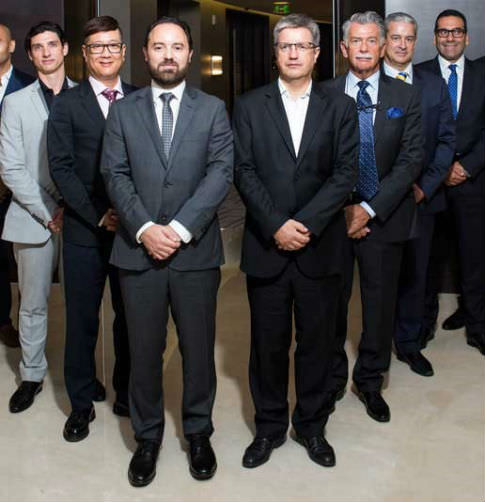

Retrofitting is an important subject, especially when the government is involved in pushing the agenda. The Dubai government has embarked upon an ambitious drive to retrofit 30,000 buildings by the year 2030, with the aim of achieving 30% energy savings.
This in turn has seen the hospitality sector adopting more retrofit projects. Key hotel landmarks across the city have undergone renovation and refurbishment works. For instance, a refurbishment programme is currently underway at Dubai’s Jumeirah Beach Hotel, which, upon completion, will offer “a refreshed look for 175 rooms and suites, and upgrades to a number of [the] most popular guest facilities”, according to the hotel’s website. In addition, hotel operator Atlantis Resorts & Residences also began a $100m (AED367m) refurbishment programme at its flagship property, Atlantis The Palm.
The hospitality sector is therefore emerging as a key industry for refurbishment works in the GCC, and particularly in the UAE. With the above in mind, we had a mix of experts from various sectors discuss the opportunities and challenges in retrofitting, at a roundtable organised by MEP Middle East.
Our participants included: Bruno Pessoa, director of technical services, Minor Hotels, Middle East and Africa; Martin Mueller, regional director of engineering, Hyatt Hotels Corporation; Alex Yoo, director of design & project management, Marriott International; Dimitri Papakonstantinou, managing director, Plafond Fitout; Stuart McGregor, GM, Trans Gulf Electromechanical; Ramy Boufarhat, COO, James L Williams Middle East; Azzam Messaykeh, CEO, Faisal Jassim Group; Raffi Kazazian, energy solutions director of Taqeef; Ian Fail-Brown, CEO, SESC Group; and Anil Mangalat, design director/partner, MMAC Design Associates.
Mueller started off by saying how a hotel could be retrofitted without disruptions to guests. He stated that there were several factors to be considered while retrofitting. He said: “The age of the building matters. Usually, older buildings have more space and so you have more options available. Secondly, location and how the operation is actually affected matter. In some areas, you can close sections. But if it’s a single building, it’s very challenging.”
Fail-Brown shared his own experience while staying at a hotel when retrofitting was ongoing. He said: “I have just stayed at the Jumeirah Beach [hotel] recently and it was in the middle of a retrofit. The work got carried out when most people weren’t in the rooms; they did sections of the property. I didn’t really find it a very major hindrance. It was managed really well.”
Yoo added to Fail-Brown’s line of thought, by saying: “A lot of it has to do with the configuration of the property, a monolithic or high-rise building as opposed to a clustered resort. I think a cluster-type plan lends itself to phasing, thereby minimising any impact to the guest experience.”
Papakonstantinou added to Mueller’s point about the age of the building and how it was built. He said: “The Kempinski in the Mall of the Emirates recently went for a more intrusive refurb. At the time that we tendered the job they had two buffer floors in between the construction areas, which obviously reduces revenue for the operator but at least it does keep the hotel operating during the refurbishment period.”
Yoo stated his observation that more projects are moving towards retrofitting in the current economic climate. “Retrofitting existing buildings has become an attractive proposition,” Yoo said. “The proportion of new-builds versus retrofit projects is shifting and the majority of our projects are conversions or retrofit projects. We’re at an important crossroads in terms of how we address these issues such as execution, implementation of technologies and strategies for energy-efficient and sustainable buildings and so forth.”
Maturity of the group
McGregor said that the maturity of the group who is doing the refurb is quite important. “I do understand the age of the building, the configuration, etc., have an impact on retrofitting. But it’s essentially about the maturity of the group who is doing the refurb and how much they actually want to contribute to having a green building, potentially shutting down sections that will impact their revenue and saying that ‘rather than having a payback period of over two or three years, we expect a payback of over 10 years’. So a lot of it has got to do with the group who operates that facility,” McGregor said.
“And the builder,” added Mangalat, “the vision that the client has for the hotel [is important]. If it’s a soft or full refurb, how fast does the client want it open? Some restaurants operate while others are being refurbed. There are operational challenges and we have to be smart about it as interior designers. Technology is a big aspect. I know most of you gentlemen are from technological backgrounds, but (audio visual information technology) AVIT is a big part of refurb. Some brands are more technology-driven than others. You are looking at a larger integration of technology and AV. It may not be possible in every retrofit.”
Kazazian latched on to Mangalat’s point on the “vision of the hotel”. Kazazian said that one needs to understand what the hotel’s goal is. He said: “Historically, we are used to seeing buildings coming down after 30 years. There is a perception that new is better than retrofitted.”
Papakonstantinou added that the whole idea that new is better than retrofitted is more prevalent in the Middle East. He said: “In Europe, or in the US, you see more retrofitting in buildings, and in fact, it’s more even desirable to have a classic 1920s building that has a history behind it. However, here in the Middle East, and possibly also due to the aggressiveness of the environment, it’s more usual to knock things down rather than refurbish them.”
“But, going forward, legislation, incentivisation by the government, and education of the general public will help. It also has to make financial sense to the developer. All these things have to sort of converge and come together. Because at the moment, going green is expensive.”